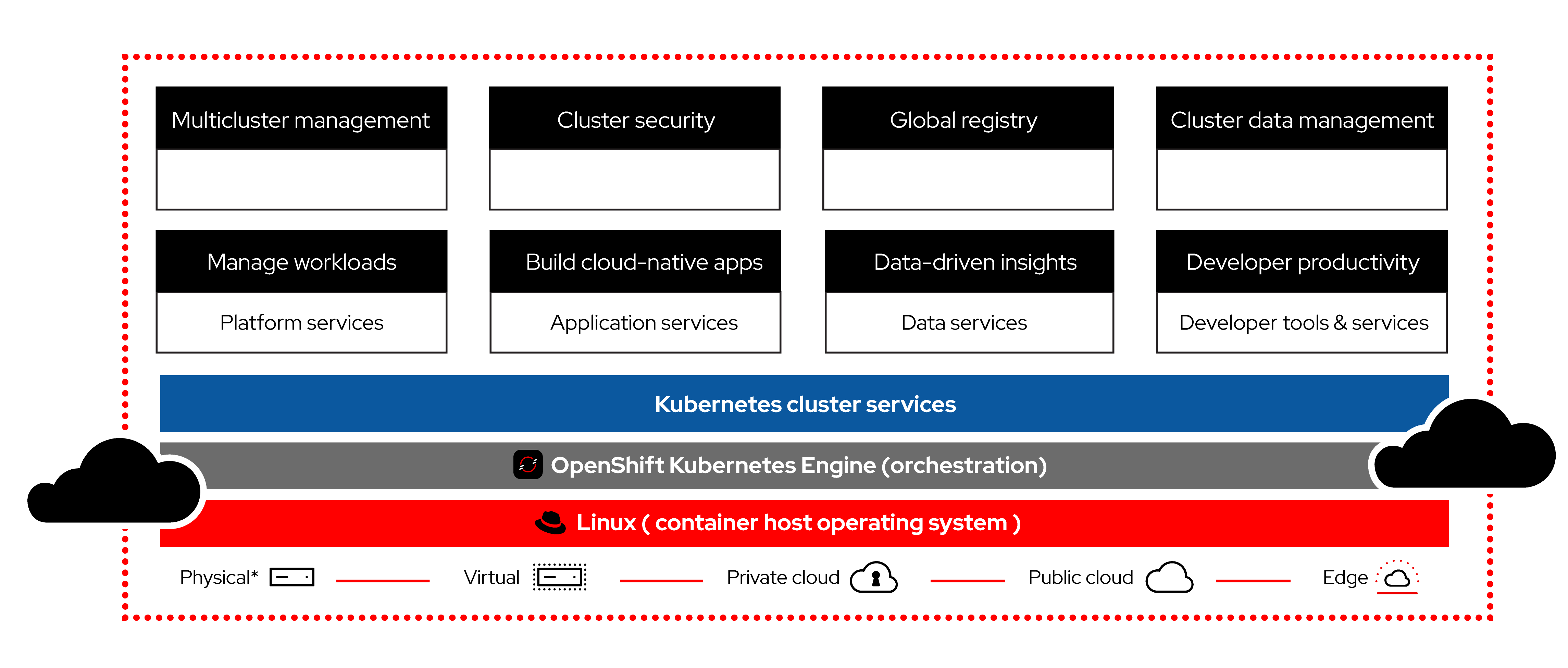Developers and DevOps can quickly build, deploy, run, and manage applications anywhere, securely and at scale with the Red Hat OpenShift. Built on Red Hat Enterprise Linux operating system and Kubernetes, Red Hat OpenShift is an enterprise-ready application platform with deployment and infrastructure options that support every application and environment.
Red Hat OpenShift
Red Hat® OpenShift® is a trusted, comprehensive, and consistent platform to develop, modernize, and deploy applications at scale, including today’s AI-enabled apps. Innovate faster with a complete set of services for bringing apps to market on your choice of infrastructure.

Explore what’s new in Red Hat OpenShift 4.20
Platform overview

Red Hat OpenShift Container Platform capabilities
Kubernetes Engine
Red Hat OpenShift Kubernetes Engine delivers the foundational, security-focused capabilities of enterprise Kubernetes on Red Hat Enterprise Linux CoreOS to run containers in hybrid cloud environments. OpenShift Kubernetes Engine and OpenShift Container Platform are built on the same enterprise Kubernetes core platform and contain key Linux, container runtime, networking, management, and security capabilities. OpenShift Kubernetes Engine is ideal for those who prefer to use their existing infrastructure and developer tool investments.
Kubernetes cluster services
A key component of the OpenShift Kubernetes Engine is the core cluster services that automate the container application environment installations, upgrades, and life-cycle management without downtime.
Manage workloads
Start with a complete set of services to build applications, including Red Hat OpenShift Serverless, Red Hat OpenShift Service Mesh, and Red Hat OpenShift Pipelines. These developer-friendly workflows enable developers to go straight from application code to container.
Build cloud-native apps
Red Hat’s product development cycle has always been rooted in open source and the communities that help to steer Red Hat’s products’ direction. Like Fedora is the upstream project for Red Hat Enterprise Linux, the projects listed here are the upstream versions of products that make up the Red Hat Ansible Automation Platform.
Data-driven insights
Data Services makes data management in the hybrid cloud or multi-cloud environment simple by simplifying access to software-defined storage and data services. With OpenShift, you can run data analytics in a consistent way across clouds to accelerate the delivery of cloud-native applications.
Introducing Red Hat AI Inference Server
Deploy your preferred models faster and more cost-effectively across the hybrid cloud with Red Hat AI Inference Server. Its vLLM runtime maximizes inference throughput and minimizes latency. A pre-optimized model repository ensures rapid model serving, while the LLM compressor reduces compute costs without sacrificing accuracy. Experience fast, accurate inference for a wide range of applications.
Red Hat AI Inference Server is included in Red Hat OpenShift AI and Red Hat Enterprise Linux AI and supported on Red Hat OpenShift and Red Hat Enterprise Linux.

Developer tools and services
Find the tools that you need to build in the cloud. Red Hat’s developer tools for Kubernetes simplify your workflow while giving you the capabilities of this powerful platform. Developers and DevOps who have chosen Java for application development can enhance their development pipeline in the world of cloud development using Red Hat’s Java tools all at no cost.
Multicluster Management
With multicluster management, get visibility and control to manage the cluster and application life cycle, security, and compliance of the entire Kubernetes domain across multiple data centers, and private and public clouds.
Red Hat Quay
The Global Registry is a private container registry that stores, builds, and deploys container images focusing on cloud-native and DevSecOps development models and environments. Developers and DevOps can analyze images for security vulnerabilities and identify issues to help reduce security risks.




